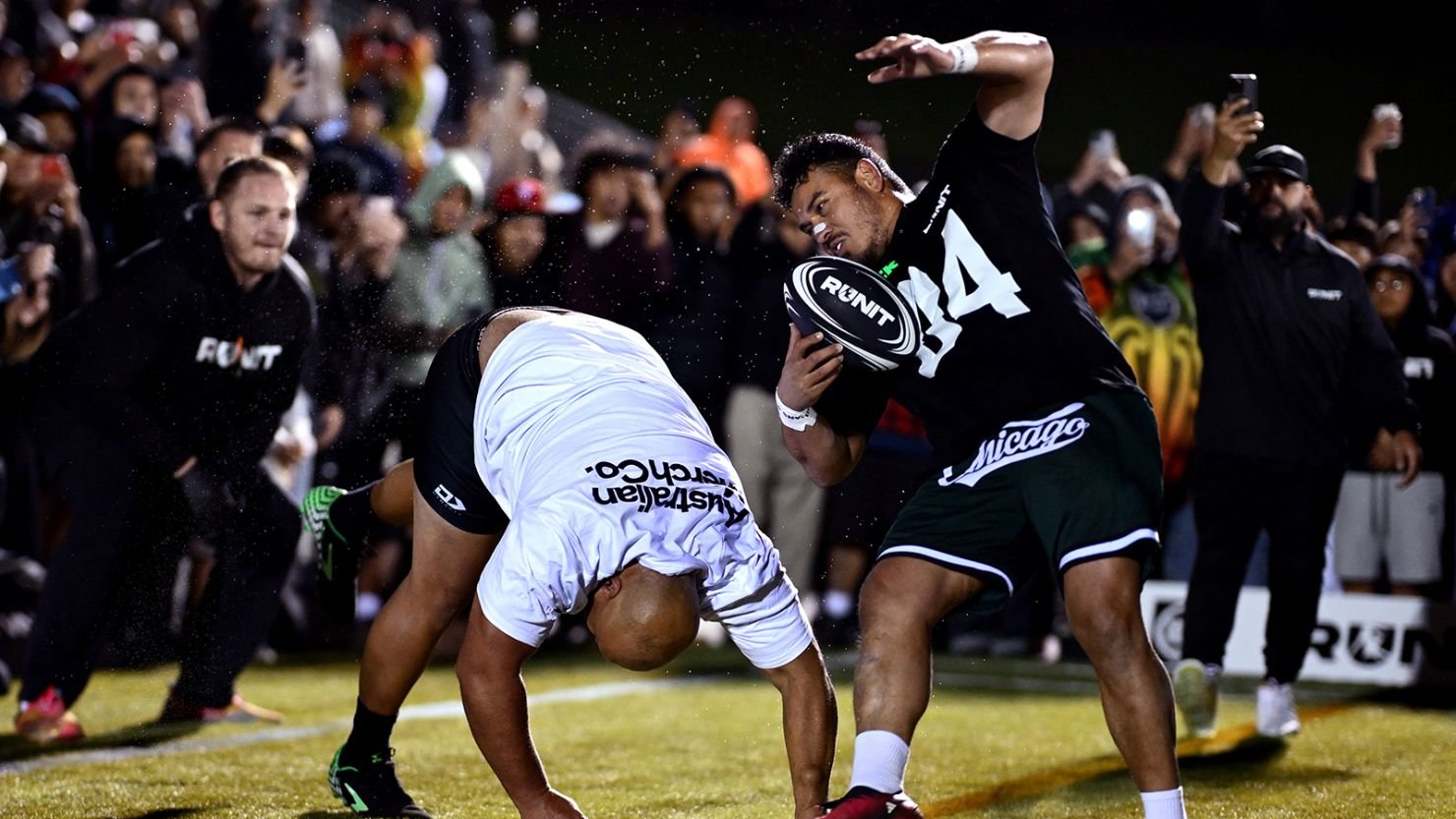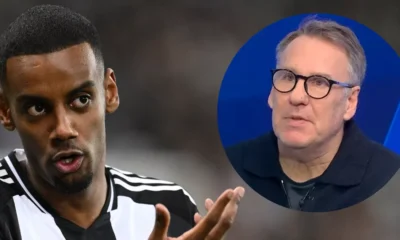Sports
Teen’s Tragic Death Sparks Global Outcry Against ‘Run It Straight’ Tackle Game
A 19-year-old’s fatal head injury reignites debate over viral rugby-style challenge turned cash-prize sport; New Zealand officials and health experts push for nationwide ban.

A shocking death in New Zealand has ignited a fierce backlash against a viral full-contact tackle game known as “Run It Straight,” as the tragic passing of 19-year-old Ryan Satterthwaite brings global attention to the lethal consequences of unregulated social media challenges.
Satterthwaite, a former student from Palmerston North, died in hospital on Monday after participating in the backyard version of the trending game during a friend’s birthday celebration. The game, popularized by online videos and influencer-led leagues, pits two players against each other in a direct, head-on sprint — with the goal to physically overpower the opponent, often without any protective gear.
The game has surged in popularity across Australia, New Zealand, and Pacific Island communities, thanks to aggressive marketing by the RUNIT Championship League, which labels itself “the world’s fiercest, new collision sport.” With prize pools as high as $118,800 (NZ$200,000), and massive exposure on platforms like TikTok and YouTube, the format has enticed countless young people — many of whom attempt it unsupervised at home.
Now, as grief and outrage mount, health officials, political leaders, and educators are urgently calling for a ban. “It’s a dumb thing to do,” declared New Zealand Prime Minister Christopher Luxon, urging youth to avoid the game and pressuring adults and influencers to stop promoting it.
New Zealand’s Minister for Sport Mark Mitchell has since sought legal advice on whether the government can intervene to restrict or outlaw such unregulated activities. “This is not a sport. It’s reckless, glorified violence,” warned Stacey Mowbray, CEO of Headway, a brain injury awareness organization.
Medical professionals, too, have sounded the alarm. According to Professor Patria Hume of Auckland University of Technology, the collision force in Run It Straight is more than five times that of a standard rugby tackle. “Ryan’s death was preventable,” she said, emphasizing the absence of any structured rules, safety measures, or medical oversight.
Despite claiming to implement safety screenings and guidelines, the RUNIT League has faced growing criticism, especially after disturbing footage emerged from a recent Auckland event where two participants were knocked unconscious — one suffering a seizure. In response, Auckland’s Trusts Arena has now banned future RUNIT events, citing “overwhelming concern” for public safety.
Even New Zealand Rugby, the official governing body for the national sport, has distanced itself from the phenomenon, releasing a public advisory urging young people not to participate. “High-contact sports like rugby come with coaching, rules, and safety frameworks. This trend does not,” they said.
The game’s creator, Christian Lesa (aka “Charizma”), has argued that the concept helped him overcome mental health struggles and that participants “know what they sign up for.” He cites inspiration from YouTuber Donald De La Haye (aka “Deestroying”), who gained fame staging 1-on-1 football challenges.
But the tragedy has sparked a deeper conversation about the role of viral content and social media in promoting dangerous behavior. “This isn’t just a teenage game gone wrong — it’s an engineered spectacle designed to go viral at any cost,” said one safety advocate.
Educational institutions are reacting swiftly. Several New Zealand schools have issued outright bans on the game within school grounds. Palmerston North Boys’ High School, which Ryan attended, had planned to warn students about the game just minutes before news of his death broke.
“It’s an absolute tragedy,” said school rector David Bovey, “and a painful reminder of how teenage invincibility can be shattered in a second.”
Sports
Shohei Ohtani finally pitches in MLB playoffs after 2,746 days… will this be the moment that defines Dodgers vs Phillies?
After years of superstardom as a hitter, Shohei Ohtani will finally take the mound in his first-ever MLB postseason pitching appearance — and the baseball world can’t wait to see if the Los Angeles Dodgers ace changes everything against the Philadelphia Phillies.

It’s the moment baseball fans have waited years to witness — Shohei Ohtani, the two-way sensation who has redefined modern baseball, is finally pitching in the Major League Baseball (MLB) postseason.
For a player who’s been called “the greatest show on Earth,” this debut on the October mound has been a long time coming — precisely 2,746 days since he first stepped into the big leagues on March 29, 2018, with the Los Angeles Angels.
ALSO READ : “From Northeastern freshman to Yankees hero… Cam Schlittler stuns Red Sox with historic playoff gem”
Back then, the world of baseball looked very different. Bryce Harper was still with the Washington Nationals, Kyle Schwarber was smashing home runs at Wrigley Field, and the Philadelphia Phillies were still buried in a decade-long playoff drought.
Fast forward to now — October 2025 — and Ohtani is the face of baseball, a two-time MVP, a World Baseball Classic champion, and the most captivating athlete the game has seen in generations.
From myth to postseason reality
Ohtani’s postseason pitching debut comes in Game 1 of the National League Division Series between the Los Angeles Dodgers and the Philadelphia Phillies — a matchup loaded with star power, storylines, and history.
Sure, Ohtani has already delivered countless unforgettable moments as a hitter:
- The first player in MLB history to hit 50 home runs and steal 50 bases in a single season.
- The man who led the Dodgers to a World Series title over the New York Yankees as a designated hitter last year.
- The national hero who struck out Mike Trout to win the World Baseball Classic (WBC) for Japan’s national team.
But now, with the ball in his hand and October lights shining bright, Ohtani faces perhaps the biggest test of his career — delivering under the pressure of the MLB playoffs.

ANAHEIM, CA -AUGUST 13, 2025: Los Angeles Dodgers starting pitcher Shohei Ohtani (17) pitches against the Angles in the first inning at Angel Stadium on August 13, 2025 in Anaheim, California.(Gina Ferazzi / Los Angeles Times)
“Everything about Ohtani has been historic,” said one ESPN analyst. “But this moment — pitching in the postseason — might finally complete his legend.”
Dodgers’ gamble could pay off in gold
The Dodgers, who signed Ohtani to a record-breaking contract, have patiently waited for this moment. They’ve managed his innings, protected his arm, and balanced his dual role as a pitcher and hitter with surgical precision.
Manager Dave Roberts called Ohtani’s return to the mound “a championship-caliber risk.”
“He’s a once-in-a-lifetime player,” Roberts said before the series. “We’ve seen him dominate with the bat, and now we get to see him dominate with the ball in his hand — when it matters most.”
Ohtani’s presence on the mound gives the Dodgers something they haven’t truly had in years: a postseason ace who also provides elite offensive production.
The Phillies, on the other hand, enter the series as one of baseball’s most confident squads — powered by Harper, Schwarber, and Trea Turner — a lineup that thrives on high-stakes chaos.
The stage is set for a baseball epic
Ohtani’s start isn’t just about one player — it’s about a sport evolving in real time. His ability to blur the lines between pitcher and slugger has changed how scouts, teams, and fans view what’s possible on a baseball diamond.
In Japan, his performance will likely stop time. Millions will tune in, just as they did during the WBC final when Ohtani and Trout faced off — a duel now immortalized in baseball history.
Former players like Ichiro Suzuki have praised Ohtani for carrying forward Japan’s baseball legacy into global superstardom. And fans across the United States see in him something rare — a reminder that greatness can still surprise us.
As one viral post on X (formerly Twitter) put it:
“Shohei Ohtani pitching in October feels like baseball’s reward for our patience.”
Can Ohtani decide the Dodgers-Phillies series?
It’s possible. Ohtani’s unique combination of power, precision, and poise could swing the entire series. The Phillies’ lineup has power, but few have ever faced a pitcher who can throw 100 mph fastballs one inning and then crush a 450-foot homer the next.
If he’s even close to his best, he could become the difference-maker between another Dodgers heartbreak and a return to World Series glory.
Win or lose, this moment feels bigger than baseball. For seven years, fans have watched Ohtani redefine what it means to be a player. Now, he finally gets the stage he deserves — the postseason mound.
And if history is any indication, Shohei Ohtani won’t just play the game. He’ll transform it.
Sports
WNBA Commissioner Cathy Engelbert faces player revolt after shocking “lucky stars” remark… what she said next stunned everyone
After Cathy Engelbert’s alleged comment that players should be “on their knees” thanking their luck for a new media deal, trust between the WNBA commissioner and her players has hit rock bottom.

The tension between Cathy Engelbert and WNBA players has reached a breaking point — and the commissioner’s latest remarks haven’t helped her case.
As the WNBA Finals tipped off on Friday night, all eyes weren’t just on the court but on the press conference podium. Engelbert, who once stood as the league’s transformative figure, is now facing the biggest credibility crisis of her tenure.
The controversy erupted earlier this week when Napheesa Collier, forward for the Minnesota Lynx, revealed during an interview that Engelbert allegedly told players they should be “on their knees, thanking their lucky stars” for the league’s upcoming $2 billion media rights deal.
ALSO READ : Taylor Swift shocks fans with bold confession in new album Life of a Showgirl
It was a bombshell accusation — one that sent shockwaves across locker rooms, fan spaces, and social media.
When asked to address the claim during her pre-Finals press conference, Engelbert’s response only deepened the distrust.
“There’s inaccuracy in what’s been reported,” Engelbert said, refusing to elaborate on what exactly was inaccurate or in what context her words were used.
Instead of clarifying, Engelbert pivoted toward her own emotional toll.
“I’m a human, too. I have a family. I have two kids who are devastated by these comments,” she said.
The reaction? A wave of disbelief — and anger — from players who expected accountability, not sympathy.
Players feel disrespected and unheard
To the athletes who’ve carried the WNBA through years of underfunding, low pay, and constant battles for recognition, Engelbert’s remarks symbolized something deeper: disrespect.
“Knowing the commissioner who’s supposed to champion us doesn’t respect us is devastating,” one player told ESPN anonymously.

Players like A’ja Wilson and Breanna Stewart have publicly pushed for fairer pay, better charter travel, and improved resources. Under the current collective bargaining agreement (CBA), the average WNBA salary remains drastically lower than that of their NBA counterparts — a gap many players view as emblematic of a deeper structural bias.
And now, with the league’s commissioner accused of downplaying player value amid billion-dollar negotiations, trust has evaporated.
A growing disconnect at the top
When Engelbert was appointed in 2019, she was hailed as a business-savvy leader who could bridge the gap between athletes and corporate power. A former CEO at Deloitte, she brought experience, polish, and big ambitions to the WNBA.
Yet, players now accuse her of becoming too corporate — more aligned with sponsors and broadcast partners than with the athletes who built the league’s foundation.
At this year’s All-Star Game, a closed-door meeting between Engelbert and players reportedly ended in frustration. Collier later described it as “fruitless,” saying there was “no real dialogue” or “sense of progress.”
“She’s supposed to be our advocate, but it feels like she’s negotiating against us,” one veteran player told The Athletic.
Social media reacts
On X (formerly Twitter), fans and analysts have been relentless.
Sports journalist Sheryl Swoopes reposted Collier’s comments, writing:
“Players built this league with sweat and sacrifice. They don’t owe anyone gratitude for a deal that finally values their worth.”
Meanwhile, WNBA legend Sue Bird liked a post that read:
“When your commissioner tells players to be grateful instead of being proud — that’s a leadership problem.”
The $2 billion question
The $2 billion media rights deal, reportedly negotiated with ESPN and other networks, was meant to be a victory lap — proof that women’s sports were finally being valued commercially.
Instead, it’s now at the center of a trust crisis.
Players are questioning how much of that windfall will reach their pockets or translate into tangible improvements — like charter flights, better healthcare, or year-round salaries.
While Engelbert has highlighted the “historic nature” of the deal, many feel her tone was dismissive of the athletes who made such growth possible.
What happens next
As the Finals continue, with Las Vegas Aces and New York Liberty battling for the championship, the off-court drama threatens to overshadow the game itself.
A new CBA negotiation looms on the horizon, and the league’s future stability could depend on whether Engelbert can rebuild trust — or if players demand new leadership altogether.
For now, one thing is clear: The commissioner’s words, or lack of them, have turned what should’ve been a celebratory moment into a credibility crisis.
And as the spotlight shifts back to the Finals, many fans are left asking: how can a league that’s finally thriving afford a commissioner who’s lost the locker room?
Sports
“From Northeastern freshman to Yankees hero… Cam Schlittler stuns Red Sox with historic playoff gem”
At just 24 years old, Cam Schlittler delivered a masterclass against his boyhood team, striking out 12 Red Sox in eight scoreless innings to keep the Yankees’ season alive.

NEW YORK — Five years ago, Cam Schlittler was just a gangly freshman at Northeastern University, staring down the dream of a lifetime: a spring training scrimmage against the Boston Red Sox.
On that February afternoon in 2020, he retired then-prospect Jarren Duran on a flyout and soaked in the surreal thrill of facing the team he grew up idolizing in Walpole, Massachusetts.
Fast forward to October 2025, and Schlittler was once again standing on the same field as the Red Sox. Only this time, it wasn’t a scrimmage — it was Yankee Stadium, Game 3 of a winner-take-all Wild Card showdown. And instead of being a wide-eyed teenager, he was the centerpiece of a roaring Bronx crowd.
The 24-year-old rookie delivered eight scoreless innings, 12 strikeouts, zero walks, and a performance that is already being hailed as one of the greatest in Yankees playoff history. New York triumphed 4-0, ending Boston’s season and keeping their own championship hopes alive.
The performance of a lifetime
Leaning on a 98.9 mph four-seam fastball, nearly a full tick faster than his regular-season average, Schlittler overwhelmed Boston’s lineup from the start.
“When you throw 100 and command the baseball, you’re a problem,” Yankees manager Aaron Boone said, smiling.

The rookie’s dominance evoked comparisons to legendary playoff debuts. By Game Score — the sabermetric formula pioneered by Bill James, Schlittler’s outing ranked top 10 in Yankees postseason history. He became the first pitcher aged 24 or younger to strike out 12 batters without a run allowed in a playoff game.
A standing ovation and a moment alone
When Schlittler walked off after a 1-2-3 seventh inning, Yankee Stadium erupted in a standing ovation. The crowd only grew louder when he returned for the eighth, becoming the first Yankees starter since CC Sabathia in 2012 to reemerge that deep into a postseason game with a lead.
The Yankees defense held back just long enough to let him stand alone on the mound — a snapshot moment destined for highlight reels. He needed only seven pitches to retire the side.
Though some staff debated letting him finish the ninth, closer David Bednar sealed the win. Still, the night belonged wholly to Schlittler.
A rookie pushed to the front
After the final handshake line, veteran ace Gerrit Cole, out for the season after Tommy John surgery, made sure the rookie was front and center.
“Yeah, I just shook his hand and got his ass up there in the front,” Cole said with a grin. “That was his game, man.”

A rapid rise
It’s a meteoric ascent few predicted. Drafted in the 7th round of 2022, Schlittler’s fastball once sat at 89 mph. But after adding muscle ahead of 2024, his velocity surged. By July 2025, after starting the year in Double-A, he was in the Yankees rotation.
“About 13 or 14 starts ago, I knew he had this in him,” Cole said. “It’s easy gas.”
What’s next
The victory sets up a tantalizing AL East Division clash against the Toronto Blue Jays, who earned a bye after edging New York in the season series. With Toronto missing key names like Bo Bichette, José Berríos, and Chris Bassitt, the Yankees may have the edge — and Schlittler is almost certain to be called upon again.
But on this night, none of that mattered. After being doused in beer in the clubhouse celebration, Schlittler was spotted walking through the tunnel, championship belt draped over his shoulder.
As teammate Max Fried passed by, he smiled and said, “Dude, you can put the belt on.”
He didn’t need to. Everyone already knew who the champion of the night was.
For more Update http://www.dailyglobaldiary.com
-

 Entertainment1 week ago
Entertainment1 week agoAlyssa Milano removes breast implants says she finally feels free and authentic
-

 Technology News1 week ago
Technology News1 week agoChina opens Shanghai digital yuan hub to rival US dollar but here’s the bigger plan
-

 Entertainment6 days ago
Entertainment6 days agoDolly Parton delays Las Vegas concerts by nine months citing health challenges but promises unforgettable return
-

 Entertainment6 days ago
Entertainment6 days agoZoey Deutch engaged to comedian Jimmy Tatro after 4 years of dating with romantic beach proposal
-

 Politics6 days ago
Politics6 days agoBarack Obama blasts Trump over Tylenol autism claim calling it ‘violence against truth’ but that’s not all he said…
-

 Sports4 days ago
Sports4 days agoTottenham’s Champions League wake-up call… why Spurs must stop looking like a Europa League side
-

 Technology1 week ago
Technology1 week agoGoogle shocks crypto world with $3B deal for Cipher Mining stake but here’s the twist
-

 Politics1 week ago
Politics1 week agoBarack Obama slams Trump administration over Tylenol autism claim calls it violence against truth




























